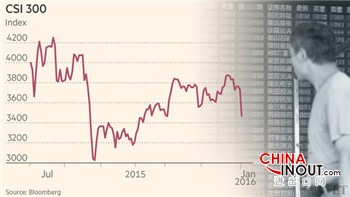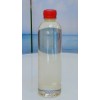中国股市在周一交易中损失巨大,首次触发新实施的“熔断机制”,提前收市。
中国蓝筹股指数沪深300(CSI 300)周一下跌7%,在新年首个交易日就遭遇了四个月以来最糟糕的一天。
深市1783支股票近1100支跌幅在9.8%到10%的个股跌停下限。上涨的股票只有30支,17只股票达到10%的涨停上限。
沪市1119支股票中上涨的仅有9支。500多支股票跌幅在9.8%到10%之间。
沪深两市10个板块全部下跌。深市下跌最严重为电信板块,跌幅达10%,下跌最轻的为消费必需品,跌幅为7.5%。沪市下跌最重的是IT板块,跌幅8.9%,下跌最轻的是能源板块,跌幅4.8%。
亚洲各股市在午后交易中也出现下跌,与中国股市大跌保持同步。
导致此次大跌的可能性原因如下:
*上周六发布的中国官方PMI指数显示中国制造业在12月份连续第五个月收缩。
*让投资者担心的还有对大股东施加的股票抛售禁令即将到期,该禁令是去年7月初监管部门施加的,当时是A股市场崩溃最严重时期,沪市市值一度蒸发掉了45%。
为了遏制夏季崩盘期间连续单日暴跌后出现的恐慌性抛售,中国监管机构推出了熔断机制,该机制紧随现有的涨跌停制度,即如果个股单日涨跌幅超过10%即停止交易。
尽管遭遇剧烈震荡,在国有金融机构——被称为“国家队”——大举买入的推动下,中国股市在去年8月下旬触低回升,2015年上证综指最终累计上涨9.4%。
但现在投资者担心放松应急救援措施可能会对市场造成新的压力,尤其当企业盈利依然不景气的时候。
中国证券监管机构于去年8月下旬暂停大规模购股,但承诺会无限期持有已购股票。去年7月强制停止的首次公开募股(IPO)也于上月恢复。中国监管机构还取消了对券商自营股票每天净买入的要求。

Trading on China’s stock market finished early on Monday after heavy losses triggered a new “circuit breaker” mechanism for the first time.
China’s blue-chip stock index, the CSI 300, suffered its worst day in four months in the year’s first trading day, falling 7 per cent on Monday.
In Shenzhen, where 1,783 stocks are listed, nearly 1,100 declined between 9.8 per cent and 10 per cent, the downward limit for individual stocks. only 30 stocks gained (and yes, because this is China’s market, 17 stock hit the upward limit of 10 per cent).
In Shanghai, where 1,119 stocks are listed, only nine stocks rose. A little more than 500 stocks fell between 9.8 and 10 per cent.
All 10 sectors in both markets fell. In Shenzhen, the ranges were from -7.5 per cent for consumer staples and -10 per cent for telecoms. In Shanghai, the range was from energy stocks falling 4.8 per cent to IT stocks shedding 8.9 per cent.
Stocks around Asia fell in afternoon trading, in tandem with the sell-off in China.
Among the possible culprits, via Gabriel Wildau in Shanghai:
* A factory survey released on Saturday showed China’s manufacturing sector shrinking for a fifth consecutive month in December.
* Investors are also nervous about the imminent expiration of a ban on stock sales by large shareholders. Regulators imposed the ban in early July at the height of the market rout that at one point had wiped 45 per cent off the value of the Shanghai market.
Regulators introduced the circuit breaker in a bid to curb panic selling after a series of big one-day losses during the summer rout. The mechanism comes on top of existing rules that halts trading in individual shares if they rise or fall by at least 10 per cent in a single day.
Despite heavy volatility, the Shanghai composite ended 9.4 per cent higher in 2015 after large-scale buying from state-owned financial institutions — known as the “national team” — fuelled a recovery from the low point touched in late August.
Now, however, investors are worried that the unwinding of emergency rescue measures could place fresh pressure on the market, even as corporate earnings remain weak.
The securities regulator halted large-scale share purchases in late August, though it pledged to maintain existing holdings indefinitely. Initial public offerings resumed last month after a halt imposed in July. And the regulator has also rescinded a ban on net share sales by securities brokerages’ proprietary trading units.











